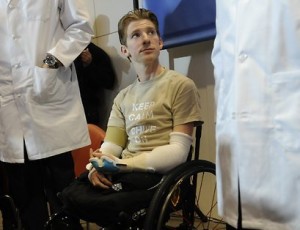Iraqi war veteran survives unprecedented transplant

U.S. Army Infantryman Brendan Marrocco recently became one of only seven other patients to successfully undergo a double arm transplant surgery.
By Marli Horwitz, Staff writer
It took thirteen hours of surgery on December 18, 2012, sixteen different orthopedic and microvascular surgeons, and one injured veteran’s determination for U.S Army Infantryman Brendan Marrocco to successfully undergo a double-arm transplant.
On April 12, 2009, the Iraqi war veteran was driving an armored vehicle back to base from Baghdad when a roadside explosion caused him to lose both arms and both legs. When the 26-year-old regained consciousness, he found himself at the Walter Reed Medical Center in Washington, DC. The Staten Island, New York native is the first quadruple amputee Iraqi war soldier to survive, and is one of only seven patients ever to successfully endure a double hand or arm transplant.
The surgery was completed at Johns Hopkins Hospital and was the first surgery of its kind to be performed there. Dr. W.P. Andrew Lee, the Director of the Department of Plastic and Reconstructive Surgery at Hopkins, was the lead surgeon. All sixteen surgeons, who came from five different hospitals in total, volunteered their services. Additionally, the costs were covered mostly by the Department of Defense’s Armed Forces Institute of Regenerative Medicine, and the remainder of the cost was provided by the John Hopkins Hospital.
According to The Guardian, at a press conference following his release from the hospital January 29, Marrocco stated, “I feel like I’m getting a second chance to start over.” According to sources at the Johns Hopkins Hospital, this transplant was “the most extensive and complicated limb transplant procedure to be performed in the United States,” requiring the connection of not only muscles and bones, but also blood vessels, nerves, tendons, and skin. Dr. Lee also explained that bone marrow from the deceased donor needed to be injected into Marrocco’s new limbs so that his body would become less likely to reject the recent additions. Although he is taking anti-rejection drugs which should help to decrease the likelihood of that happening, the transplant will continue to be classified as “dangerously risky,” and Dr. Lee said drugs can sometimes cause infections and damage to organs.
The surgery may be complete, but the hard work is just getting started for Marrocco. For the next two to three years, his primary focus will be participating in hand therapy up to six hours per day, until his new nerves grow in. Regeneration of the nerves can grow at a maximum speed of one inch per month so this therapy will continue first at Johns Hopkins and then at Walter Reed, according to CNN.
Despite his devastating injury and critical condition, Marrocco clings to an inspiring amount of positive attitude and is expectant of a happy future. According to CNN, he says, “I just want to get the most out of these arms and just as goals come up, knock them down, and take it as absolutely far as I can…and just get back to enjoying life.” He’s looking forward to hand cycling, swimming, and especially driving his beloved black Dodge Charger. The devoted veteran and his family all note that with his stubborn attitude to pull through and his ability to persevere, Marrocco will stop at nothing to achieve the ultimate goal: independence.
